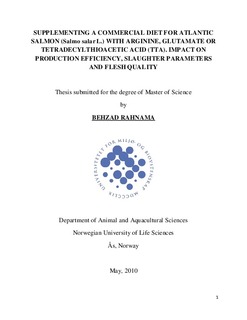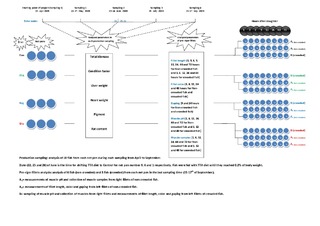| dc.description.abstract | The present study was carried out to evaluate the effects of supplementing a commercial diets with 1.5% L-arginine, 1.5% L-glutamate or 0.25% tetradecylthioacetic acid (TTA) on feed intake, feed utilization and growth parameters of Atlantic salmon (Salmo salar L.) during the critical periods after sea transfer with regard to seawater adaptation and onwards, from April to September. In the case of TTA, fish were fed until they reached a weight gain of 0.2% of the initial body weight, thereafter the TTA diet was replaced by the control diet. The arginine and glutamate diets were fed throughout the whole experimental period. At the experimental termination, effects of dietary treatments on rigor development, post-mortem energy metabolism and selected quality parameters of fish exposed to normal slaughter handling and stress exposure (crowding stress for 16 hours) were also studied. 6000 smolts of Atlantic salmon with an average weight of 105 grams were transferred to 12 net pens in sea water (500 smolts per each net pen). Three net pens were assigned for each of the four dietary treatments. Fish were sampled initially and once a month (five samplings). No significant differences in body weight, thermal growth coefficient (TGC), specific growth rate (SGR), feed conversion ratio (FCR) or specific feed ratio (SFR) were observed between dietary treatments, but numerically the performance was the best for the salmon fed the arginine supplemented feed, whereas the numerically lowest performance was observed for the salmon fed the TTA diet. The hepatosomatic index (HSI) of the TTA group was significantly higher compared with the control and arginine groups in June (feeding TTA diet was stopped at this time), whereas in September, the TTA group had the numerically lowest HSI (significant from the glutamate group). Cardio somatic index (CSI) did not differ significantly among the dietary treatments, but the condition factor was lowest of the TTA group, whereas the arginine and glutamate diets tended to enhance muscularity. Pigmentation of fillets did not show any significant differences between dietary treatments, but the fat content of fish fed TTA was significantly lower than other dietary treatments.
Developments in the following parameters were recorded during storage of pre-rigor fillets of non-crowded and crowded salmon in September: rigor contraction, fillet color, gaping, muscle pH, and adenosine triphosphate (ATP). Additionally, cathepsin B, L and B+L activity were analyszd immediately after slaughter. The TTA and arginine groups seemed to have the slowest contraction rate of the non-crowded fish, and after 72 hours storage, the TTA diet was significantly lower compared to the control group. However, in crowded fish, the contraction of the TTA group was significantly highest initially, whereas the numerically lowest contraction was observed for the arginine group. After 12 hours, fillet color of fish fed glutamate was significantly higher than of fish fed control diet in the non-crowded group, but in crowded fish the color of the glutamate group tended to be palest. Muscle pH showed significant variations between dietary treatments for non-crowded fish after 1, 12, 24 and 72 hours storage, where the muscle pH was significantly lower of fish fed TTA diet after 1 and 12 hours and of fish fed
10
arginine diet after 24 and 72 hours compared to the control diet. In contrast, muscle pH of the TTA group exposed to crowding was significantly highest together with the glutamate diet after 12 hours storage compared to the control group. For crowded fish, cathepsin B activity of the arginine, glutamate and TTA group was significantly lower than of the control group. No significant impact of dietary treatments were observed on fillet gaping or ATP content. Crowding stress prior to slaughtering significantly accelerated rigor contraction, muscle pH degradation, and ATP depletion. Furthermore, the gaping score was higher in crowded fish, but fillet color and cathepsins activity did not differ significantly. | en_US |

